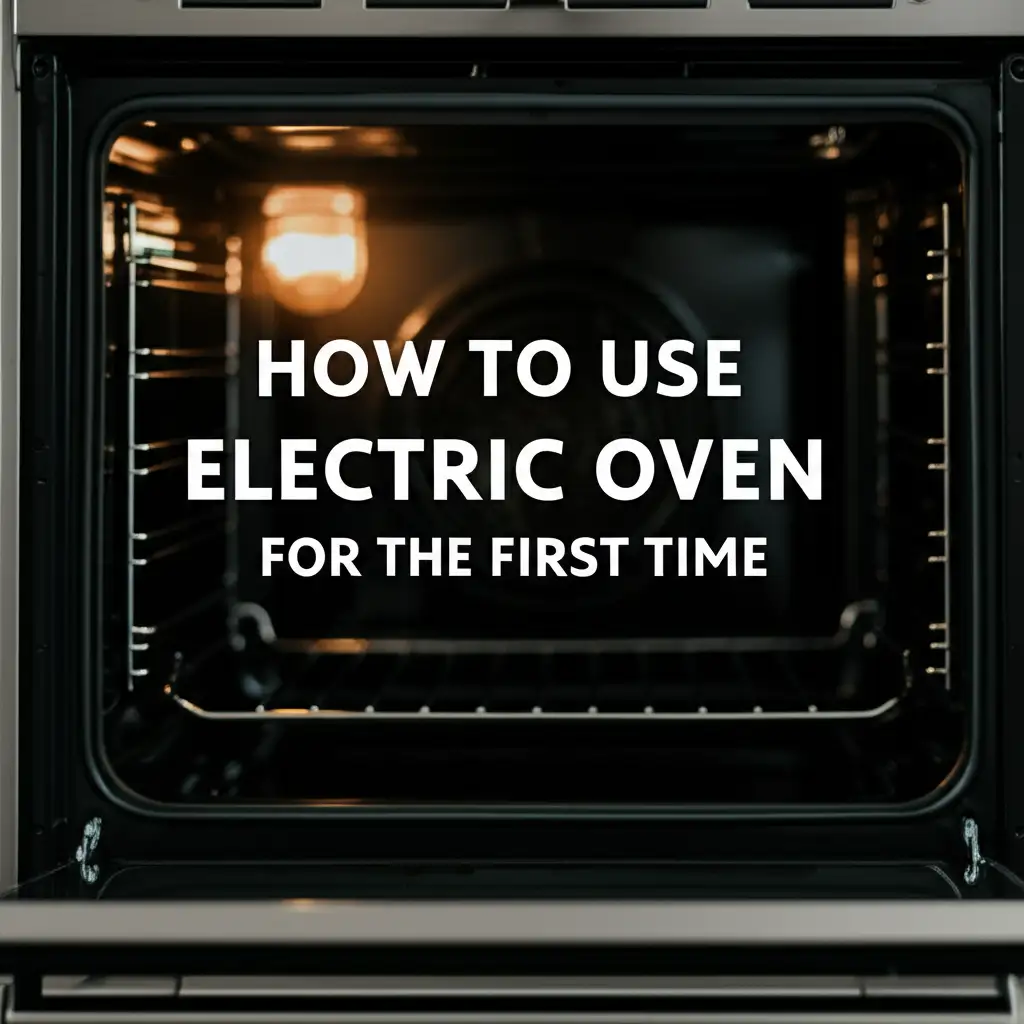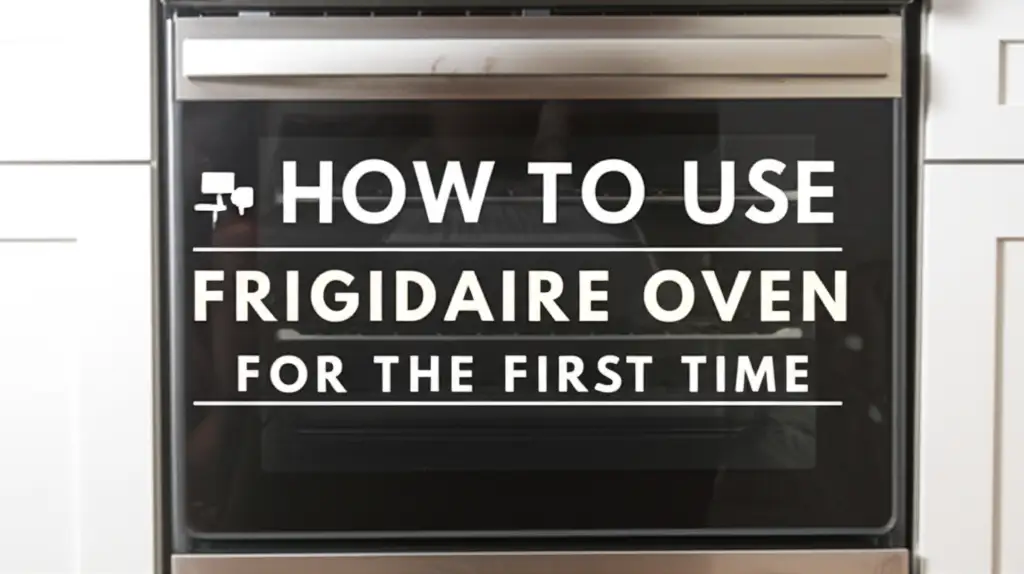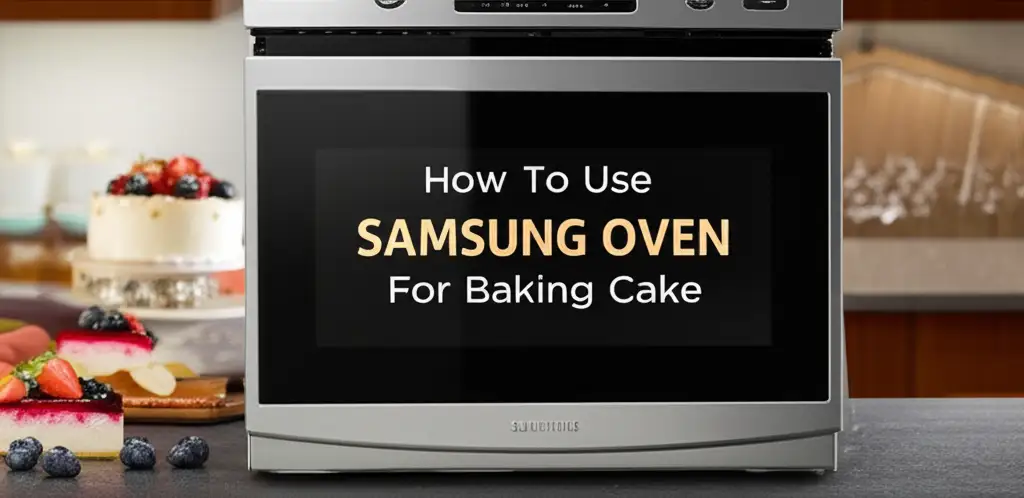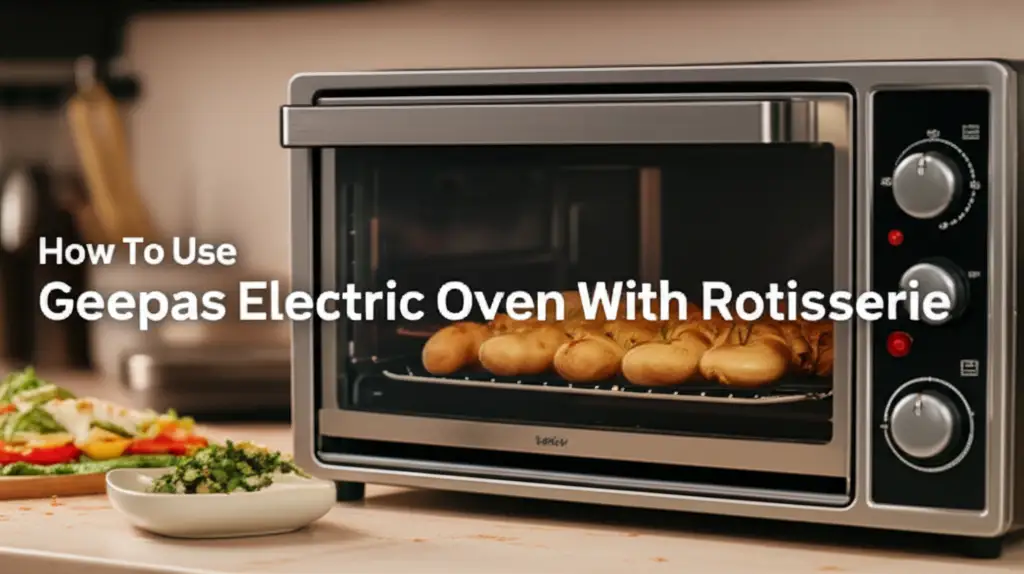· Katria Melrose · Kitchen Appliances · 18 min read
How To Use Electric Oven For The First Time

Mastering Your Electric Oven: A First-Time User’s Guide
Bringing a new electric oven into your home is an exciting step. You now have a powerful tool for countless delicious meals. However, knowing how to use an electric oven for the first time can feel a bit daunting. Many people wonder about initial setup, specific settings, or even basic safety. You might feel a mix of excitement and uncertainty as you look at the control panel.
This guide will walk you through every step. We cover everything from initial preparation to your first cooking adventures. You will learn about important safety measures and simple cleaning tips. My goal is to make your first experience smooth and successful. Let’s get started on your journey to confident oven use!
Takeaway:
- Perform an initial burn-off to remove manufacturing odors.
- Understand your oven’s specific controls and functions.
- Always preheat the oven properly for best cooking results.
- Prioritize safety by using appropriate ovenware and ventilation.
- Clean your oven regularly to maintain its performance.
How do I use an electric oven for the first time?
To use an electric oven for the first time, you must first perform an initial burn-off to eliminate manufacturing odors. Then, set the desired temperature using the control panel and allow the oven to preheat fully. Place your food inside, follow cooking times, and always observe essential safety guidelines.
Preparing Your New Electric Oven for Its First Use
Setting up your new electric oven correctly ensures a smooth start. This initial phase involves checking for damage and performing a vital burn-off. Taking these steps prevents issues and prepares your oven for safe cooking. It is a simple process, but it makes a big difference.
First, unpack the oven carefully. Remove all packing materials, including tape and cardboard inserts. Check inside the oven cavity and remove any accessories wrapped in plastic or cardboard. Make sure no small pieces of packaging remain. This step prevents melting plastic or burning paper during operation. Next, push the oven into its designated spot. Ensure it sits level and stable. Connect the power cord to a dedicated outlet. If you have a range, make sure the plug is fully inserted.
An important step for all new electric ovens is the “burn-off.” This process removes manufacturing oils and protective coatings. These materials can cause a strong odor and sometimes smoke during the first few uses. A burn-off helps dissipate these smells before you cook food. It creates a cleaner environment for your dishes. You should never skip this step.
The burn-off process is straightforward. First, open nearby windows or turn on your kitchen exhaust fan. This provides good ventilation. Remove all oven racks and accessories. Wipe the interior with a damp cloth to remove any dust. Set your oven to a high temperature, usually 350-450°F (175-230°C). Let it run for 30-60 minutes. You might see some light smoke or smell a faint odor; this is normal. After the time passes, turn off the oven and let it cool completely. Wipe the interior again with a damp cloth once cool. This readies your oven for its first meal. Remember to follow any specific burn-off instructions in your oven’s manual.
Before you begin, it can be helpful to understand the basic type of oven you have. If you are unsure, you can find helpful information on how to know if you have an electric oven. This ensures you are following the correct instructions for your appliance.
Deciphering Your Electric Oven’s Control Panel and Functions
Understanding your electric oven’s control panel is key to using it effectively. Each oven model has its own unique layout. However, most electric ovens share similar basic functions. Taking a few moments to familiarize yourself with these controls will make cooking much easier.
Most control panels have a dial or a touch screen. This is where you select the cooking mode and temperature. Common cooking modes include Bake, Broil, and often Convection Bake. The “Bake” setting heats the oven from the bottom and top elements, providing even heat for most dishes. It is the most common setting for cakes, cookies, and casseroles. “Broil” uses only the top heating element at a very high temperature. This is good for quickly browning food, like melting cheese or crisping chicken skin. You should keep a close eye on food when using the broil setting.
Convection ovens have an added fan that circulates hot air. This fan ensures more even cooking and often reduces cooking times. If your oven has a “Convection Bake” setting, you might need to adjust recipe temperatures down by 25°F (15°C). You may also reduce cooking times by about 25%. This setting is great for roasting vegetables, baking multiple trays of cookies, or achieving crispier results. Always check your oven’s manual for specific recommendations on using convection. Some ovens even have a “Convection Roast” setting, which combines the fan with higher heat for excellent roasting.
Beyond basic modes, your oven likely has a timer function. This feature helps you track cooking times accurately. Some timers simply count down and beep, while others can turn the oven off automatically. Many ovens also include a light button to illuminate the interior, allowing you to check on food without opening the door. Other common features might include a self-clean cycle, delayed start options, or a warming setting. Reading your specific model’s manual will explain all available features. It also provides important details about their safe and correct operation.
Always read your oven’s manual. It provides specific details about your model. It also explains any unique features or settings. This knowledge helps you use your oven safely and efficiently.
Mastering Temperature and Preheating for Optimal Results
Accurate temperature and proper preheating are fundamental for successful cooking in an electric oven. Many common cooking mistakes stem from not fully understanding these two elements. Getting them right will lead to perfectly cooked meals every time.
Preheating your oven means bringing it to the desired temperature before you put food inside. This step is crucial for almost all recipes. When you place food into a cold oven, it starts cooking slowly. This can affect the food’s texture, rise, and overall doneness. For instance, cakes might not rise properly, and roasts might dry out. A fully preheated oven provides an immediate burst of heat. This sets the food’s exterior quickly, locking in moisture and promoting even cooking. Always wait until your oven signals it has reached the set temperature. Do not rely on the display showing the target temperature immediately. The heating elements need time to stabilize.
Most electric ovens have an indicator light or a chime that signals when the set temperature is reached. This usually happens within 10-15 minutes. However, for baking sensitive items like cakes, cookies, or bread, it is often wise to wait an additional 5-10 minutes. This extra time allows the oven interior, including the racks and walls, to absorb the heat. This creates a more stable and consistent cooking environment. Opening the oven door frequently during preheating or cooking lets heat escape. Avoid doing this unless necessary. Every time you open the door, the oven temperature can drop significantly. This prolongs cooking times and can impact food quality.
Electric ovens heat differently than gas ovens. Electric elements often cycle on and off to maintain temperature. This cycling can lead to slight temperature fluctuations. For consistent results, it is vital to trust the preheating signal. If you find your electric oven consistently burns the bottom of items, this could be due to issues with element cycling or rack placement. You can explore remedies for this issue by learning why does my electric oven burn the bottom of everything. Placing a baking stone or an empty baking sheet on a lower rack can sometimes help regulate bottom heat. Always use an oven thermometer to verify the temperature if you suspect your oven is not calibrated correctly.
Remember, consistent temperature equals consistent cooking. Patience during preheating is a virtue that pays off in delicious results.
Essential Safety Measures When Operating an Electric Oven
Safety is paramount when using any kitchen appliance, especially an electric oven. Following basic safety guidelines protects you, your home, and your delicious creations. Many common kitchen accidents are preventable with simple precautions.
Always ensure your oven is clear of any flammable materials. This includes dish towels, paper, or plastic items. Do not store anything inside the oven when it is not in use. Sometimes, people store baking sheets or pots in the oven. Forgetting to remove these before preheating can cause odors, smoke, or even fires if they are not oven-safe. Before turning on your oven, always peek inside. Make sure it is empty. This simple check prevents many potential hazards.
Using proper ovenware is another critical safety point. Always use bakeware designed for oven use. Glass, ceramic, cast iron, and metal pans are generally safe. Avoid using plastic containers or disposable aluminum foil trays for high-temperature cooking unless they are explicitly labeled as oven-safe. Always check the maximum temperature rating for your dishes. Oven mitts or heat-resistant gloves are essential when handling hot dishes. Never touch hot surfaces with bare hands. Pull out racks only partway to avoid reaching deep into a hot oven. This prevents accidental burns.
Good ventilation is important, especially during the initial burn-off or when cooking smoky foods. Turn on your range hood or open a window. This helps clear the air of fumes and odors. If you experience excessive smoke or a strong burning smell at any time, turn off the oven immediately. Unplug it if possible and investigate the cause. Do not use your oven to heat your home. Electric ovens are designed for cooking, not for space heating. Doing so is inefficient, costly, and poses a serious fire risk due to carbon monoxide buildup and overheating. You can find more information about this by understanding can I use my electric oven to heat my house.
Never leave your oven unattended, especially when broiling or if using a self-clean cycle. A quick check-in every few minutes can prevent problems. Many people wonder about leaving an electric oven on when not home. Generally, it is not recommended to leave an electric oven on when you are not home due to potential risks, though modern ovens have safety features. For more details on this specific concern, you can read about can you leave electric oven on when not home. Always disconnect the power if you need to perform maintenance or if you notice any unusual electrical issues. Regular checks of the power cord for fraying or damage are also wise.
Cooking Basics: Your First Steps with Baking and Roasting
Once your electric oven is prepped and you understand the controls, it’s time for the fun part: cooking! Starting with simple recipes will build your confidence. Electric ovens excel at both baking and roasting, offering consistent heat for delicious results.
For baking, precision is key. Always use the “Bake” setting unless your recipe specifically calls for convection. Ensure your oven is fully preheated as discussed earlier. Place your baking dish or cookie sheet on the center rack. The center rack typically provides the most even heat distribution. If you are baking multiple items, try to leave some space around each pan for air circulation. Overcrowding the oven can lead to uneven baking. If you need to use two racks, consider rotating the pans halfway through cooking. This helps ensure both trays cook evenly. For items like cookies or bread, a baking stone or a heavy-duty baking sheet can help create a more consistent heat for the bottom.
Roasting in an electric oven is also straightforward. Whether you’re roasting vegetables or a cut of meat, higher temperatures often yield better results. Use the “Bake” or “Convection Bake” setting, depending on your desired outcome. Convection is great for achieving crispier exteriors on roasted potatoes or chicken. Place your food on a roasting pan or a baking sheet with a wire rack. This allows hot air to circulate all around the food, promoting even browning. For meats, using a meat thermometer is the most accurate way to ensure it’s cooked to a safe internal temperature. Remember to let roasted meats rest for a few minutes after taking them out of the oven. This allows the juices to redistribute, resulting in a more tender and flavorful product.
Don’t be afraid to experiment with your electric oven. Start with simple recipes like roasted vegetables, baked potatoes, or a basic batch of cookies. Pay attention to how your oven cooks. Note any hot spots or areas where food browns faster. Over time, you will develop a feel for your specific oven’s quirks. This knowledge will help you adjust cooking times or temperatures for various dishes. A reliable oven thermometer can also be a valuable tool to verify your oven’s accuracy. Keep it inside the oven to monitor the actual temperature. This ensures your recipes turn out perfectly every time.
Common Cooking Challenges and Simple Fixes for Electric Ovens
Even with a brand new electric oven, you might encounter some common cooking challenges. These issues are often easy to fix once you understand their cause. Knowing how to troubleshoot helps you maintain consistent, good results.
One frequent complaint is uneven cooking or browning. This means one part of your food cooks faster than another. In electric ovens, this can happen if the heating elements cycle on and off, creating slight temperature variations. To fix this, rotate your food halfway through the cooking time. For example, if you’re baking a cake, turn the pan 180 degrees. If using multiple racks, swap their positions. Make sure your oven is not overcrowded. Leaving space between dishes allows heat to circulate properly. Also, consider using lighter-colored, heavy-gauge bakeware, as darker pans absorb more heat and can cause faster browning.
Another common issue is food burning on the bottom while the top remains undercooked. This is a tell-tale sign of too much heat from the bottom element. This problem is particularly noticeable with pizzas, breads, or certain casseroles. To remedy this, try moving your oven rack up one position. For example, if your recipe calls for the middle rack, try the rack above it. Alternatively, place an empty baking sheet or a ceramic baking stone on the rack below your food. This acts as a heat shield, diffusing the direct heat from the bottom element. If you consistently find your electric oven burns the bottom of everything, you might want to look into dedicated solutions for this specific problem. You can find more targeted advice on why does my electric oven burn the bottom of everything.
Sometimes, you might find food takes longer to cook than the recipe suggests. This could indicate your oven’s temperature is lower than what the display shows. A simple, inexpensive oven thermometer placed inside the oven will confirm the actual temperature. If there’s a significant difference, you’ll know to adjust your oven’s temperature setting accordingly. For example, if your oven reads 350°F but the thermometer shows 325°F, you should set your oven to 375°F for recipes requiring 350°F. Another factor is frequently opening the oven door, which causes temperature drops. Resist the urge to peek often. Use the oven light instead.
Lastly, watch for excessive smoke or strange odors during cooking. While a new oven has an initial burn-off smell, persistent smoke usually indicates food spills. Clean any drips immediately after the oven cools. If you experience electrical smells or persistent smoke without spills, turn off the oven and consult a professional.
Maintaining and Cleaning Your Electric Oven for Lasting Performance
Keeping your electric oven clean ensures it performs well for years. Regular maintenance also prevents buildup that can cause odors or even affect cooking efficiency. Cleaning an electric oven is not a difficult task, and it helps your appliance last longer.
For daily maintenance, wipe up spills as soon as the oven cools. Food splatters can bake onto the oven’s surfaces, becoming harder to remove later. Use a damp cloth and a mild soap solution for fresh spills. A quick wipe down after each use keeps the interior relatively clean. This also helps prevent unpleasant smells from burnt food residue during future cooking. Pay attention to the oven door and glass. Food often splatters here. Keeping the glass clean allows you to monitor your food without opening the door.
For deeper cleaning, your electric oven likely has a self-clean feature. This cycle uses very high temperatures to burn off food residue. The residue turns into ash, which you can easily wipe away. Before running the self-clean cycle, remove all oven racks. Also remove any aluminum foil or large food debris. Ensure your kitchen is well-ventilated during this process. The high heat can produce strong fumes and odors. Once the cycle finishes and the oven cools completely, wipe out the ash with a damp cloth. It is important to note that the self-clean cycle is very intense. Using it too frequently can potentially reduce the lifespan of some oven components. Most manufacturers recommend using it only a few times a year.
If you prefer not to use the self-clean feature, or if your oven does not have one, you can clean it manually. For manual cleaning, let the oven cool completely. Remove the racks. You can wash racks in the sink with warm, soapy water. For the oven interior, use a commercial oven cleaner or a paste made of baking soda and water. Apply the cleaner according to product instructions. For baking soda paste, spread a thick layer over soiled areas. Let it sit overnight. Then, scrub with a non-abrasive sponge or cloth. Wipe thoroughly with a damp cloth to remove all residue. Always avoid getting cleaner on the heating elements. For a comprehensive guide on keeping your appliance sparkling, learn how to clean electric oven.
Regular cleaning not only keeps your oven looking good but also ensures accurate temperatures and efficient operation. A clean oven is a happy oven, and it helps you prepare delicious meals without issue.
FAQs About Using Your Electric Oven for the First Time
Q1: How long does it take for an electric oven to preheat?
An electric oven usually takes 10 to 15 minutes to reach its set temperature. This time can vary based on the specific model and the target temperature. For sensitive baking, it is best to wait an additional 5-10 minutes after the preheat signal. This allows the oven walls and racks to fully absorb the heat.
Q2: Can I put aluminum foil on the bottom of my electric oven?
No, you should not place aluminum foil directly on the bottom of an electric oven. Doing so can trap heat, damage the oven’s finish, or interfere with temperature sensors. It can also block airflow, leading to uneven cooking. Always use oven-safe liners or place foil on a rack under the food.
Q3: What oven settings should I use for general baking?
For general baking, such as cakes, cookies, or casseroles, the “Bake” setting is usually best. This setting uses heat from both the top and bottom elements for even cooking. If your oven has a “Convection Bake” setting, you can use it, but remember to adjust the temperature down by about 25°F (15°C) and reduce cooking time.
Q4: Why does my electric oven smell bad when I first use it?
A new electric oven often produces a distinct smell during its first few uses. This is normal and comes from manufacturing oils and protective coatings burning off. Performing an initial “burn-off” cycle (running the empty oven at high heat for 30-60 minutes) helps to dissipate these odors before you cook food.
Q5: How often should I clean my electric oven?
The frequency of cleaning depends on your cooking habits. For light use, a good wipe-down after spills and a deeper clean every few months is sufficient. If you cook frequently or have many splatters, more frequent cleaning is advisable. Use the self-clean cycle sparingly, perhaps 2-4 times a year, to preserve oven components.
Q6: Should I always use an oven thermometer?
Using an oven thermometer is highly recommended, especially when you first use an electric oven. Built-in oven thermostats can sometimes be inaccurate. An external thermometer provides a precise reading of the actual temperature inside your oven. This helps ensure your recipes cook correctly and consistently.
Your Journey to Confident Electric Oven Cooking Begins Now
Congratulations! You have now learned how to use an electric oven for the first time. We covered everything from essential initial preparations, like the crucial burn-off, to understanding your oven’s controls. We explored how important proper preheating is for successful cooking and discussed vital safety practices. You are now equipped with the knowledge to bake and roast with confidence.
Remember, patience and practice are your best tools. Start with simple recipes, observe how your oven performs, and do not hesitate to consult your oven’s manual for specific details. By following these steps, you will quickly become comfortable with your new appliance. Your electric oven is a powerful kitchen tool. Use it to create countless delicious meals for yourself, your family, and your friends. Happy cooking!





